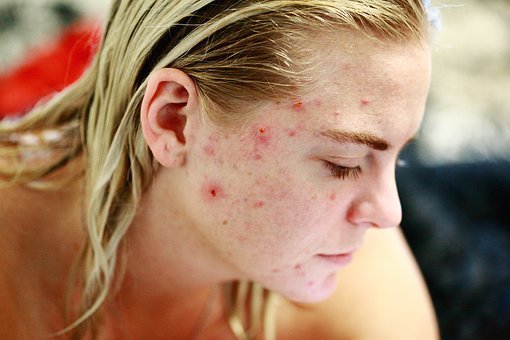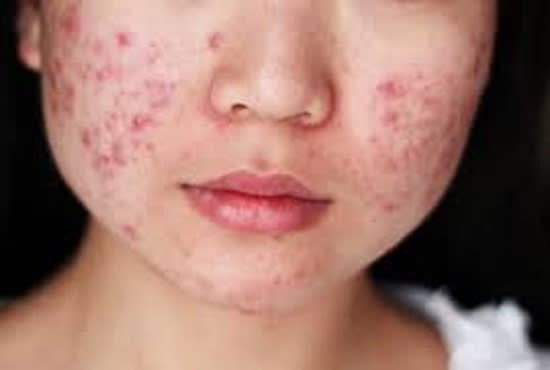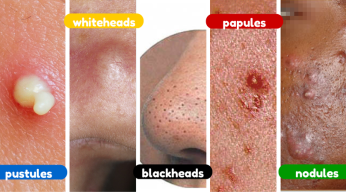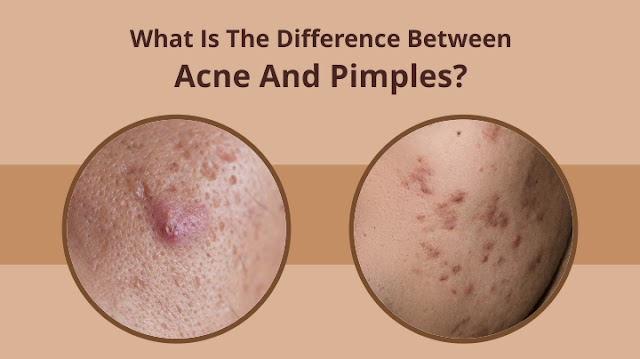1- Acne is a common skin condition that occurs when the pores under the skin become clogged. Oil and dead skin cells clog pores and spread sores (often called pimples or small scars). Most often, it spreads on the face, but also on the back, chest and shoulders.
For most people, acne will go away by the time they reach the age of thirty, but for some people this skin problem will continue into their forties and fifties.
2- Acne is a chronic, inflammatory skin condition that affects the face, shoulders, back, neck, chest and upper arms.
ALTERNATIVE NAMES:
Pimples; Cystic pimples; Pimples on face,; Zits
TYPES:
Acne scars vary in size, color and level of pain.
The following types are possible:
Whiteheads:
These live under the skin and are small
Blackheads: Clearly visible, they are black and appear on the surface of the skin
Papules:
Small, usually pink bumps that appear on the surface of the skin
Blisters: Clear on the skin surface. They are red at their base and pus at the top
Nodules:
Clearly visible on the skin surface. They are large, firm, painful pimples that are deeply embedded in the skin.
Cyst:
Clearly visible on skin surface. They are painful and fill with pus. Ulcer scars form.
CAUSE OF ACNES:
Doctors believe that one or more of the following can cause acne:
- Formation of dead skin cells in pores.
- Bacterial growth in pores.
- The following factors may contribute to your acne:
If any of your parents have severe acne, it can be very difficult to control your acne.
Some medications include iodides, bromides or injectable steroids (medically prescribed prednisone [Deltasone, Orazone, Prednisone-M, Liquid Pred] or steroids that can cause or exacerbate acne, sometimes in body builders or athletes). Other medications that can cause or increase acne include anticonvulsant drugs and lithium (Escalit, lithobid). However, most cases of acne are not medication related.
- The following do not cause acne, but can make it worse.
Parents often tell teenage children to stay away from pizza, greasy and fried foods and junk food. While these foods are not good for overall health, they do play an important role in acne. Although some recent studies have linked high carbohydrate diet, milk and pure chocolate to exacerbating acne, these findings have not been established.
Some people are so upset with their pimples that they hold them for a long time. Stress, however, plays a direct role in causing acne.
- Pressure from a sports helmet, tights or backpack.
In some patients, the pressure of helmets, straps, collars, suspenders, etc. can aggravate acne.
- Pollution and high humidity. Dirt
Blackheads are oxidized oil, not dust. Sweat does not cause acne and is produced by completely different glands in the skin. On the other hand, excessive washing can dry out the skin and cause irritation. pollution may cause if pores open.
- Squeezing or peeling at the pimple.
- Scrubbing your skin very hard.
Hormonal factors:
Many factors trigger acne, but the main reason is likely to be increased androgen levels.
Androgen is a type of hormone that increases during adolescence. In women, it is converted to estrogen.
An increase in androgen levels causes the oil glands under the skin to expand. The enlarged gland produces more sebum. Excess sebum breaks down the cellular walls in the pores, causing bacteria to grow.
Other possible triggers:
- Some studies suggest that genetic factors may increase the risk.
- Delicate, oily cosmetics:
Some cosmetics and skin care products are clogged ("comedogenic.) Of the many brands of skin care products available, if you are concerned about acne, it is important to read the list of ingredients and choose the ones that contain first or second water. These "water-based" products are generally best for people with acne.
Acne mainly affects the face and shoulders. It also occurs on the torso, arms, legs and buttocks. Skin changes include:
Crust of skin tumors
Ulcer
Papules (small red lumps)
Acne (small red spots with white or yellow pus)
The skin is red around the eruption
Skin scars
Whiteheads
Blackheads
WHAT IS ACNE SCARS?

Acne scars are caused by inflammation of the acne scars. Acne pores swell and cracks in the wall of the pores. Some acne scars are small and the formed scars are shallow and heal quickly. Sometimes the contents of the scars spread to the surrounding tissue and cause deep scars. The skin's response is to repair the scar by creating new collagen fibers.
Scarring occurs when there is tissue damage, resulting in indentation on the skin surface; Or, an increased scar may form up to the surface of the skin. These types of acne scars are, in fact, a sign that your skin is doing its job — but probably not very well. Your skin's collagen ("repair tissue") can help heal wounds - acne - but if it is high in collagen, increased scars will form.
Just because you have acne does not mean you get scars. And if you do (one in five people with acne get scars), the good news is that not all acne scars are permanent! Treatments are available. Some treatments actually remove scars, while others help the skin heal with its own collagen.
DIFFERENCE BETWEEN ACNES AND PIMPLES?
Acne" is a disease and Pimple" is one of its symptoms.
Acne is a condition that affects the hair and oil glands of the skin.
Underneath your skin, your pores are connected with glands that make an oily substance called sebum. The glands and pores are connected by a canal called the follicle, which contains thin hairs that extend to the surface of the skin.
When sebum and dead skin cells form, they form a plug in the follicle. The bacteria in the plug cause inflammation and red pimples on the face, neck and body.
TREATMENT:
Acne medications work by reducing oil production and inflammation or by treating bacterial infections. With most prescription acne medications, you will not see results for four to eight weeks. It can take months or years for your pimples to clear up completely.
The treatments recommended by your doctor depend on your age, type and severity of your acne and what you want to do. For example, you may need to wash and medicate your affected skin twice a day for several weeks. Topical medications and medications that you take orally are often used in combination. Treatment options for pregnant women are limited due to the risk of side effects.
Talk to your doctor about the risks and benefits of the medications and other treatments you are considering. And make a follow-up appointment with your doctor every three to six months until your skin improves.
Topical Medications:
The most common topical prescription medications for acne are:
Drugs such as retinoids and retinoids. Medications containing retinoic acid or tretinoin are often helpful for moderate acne. They come in the form of creams, gels and lotions. Examples are tretinoin ( Retin-A, others), adapalene . You can apply this medicine in the evening and start three times a week when your skin gets used to it. It prevents hair follicles. Do not apply tretinoin in the same way as benzoyl peroxide.
Topical retinoids increase your skin's sun sensitivity. They can also cause dry skin and redness, especially in those with fair skin. Adapalene is best tolerated.
Antibiotics:
These work by killing excess bacteria on the skin and reducing redness and inflammation. For the first few months of treatment, you can use both retinoid and antibiotic, antibiotic in the morning and retinoid in the evening. Antibiotics often combined with benzoyl peroxide reduce the chance of developing antibiotic resistance. Examples are clindamycin with benzoyl peroxide et al.) And erythromycin with benzoyl peroxide . Only topical antibiotics are not recommended.
Hormone Therapy:
Hormone therapy often benefits women with acne, especially if the pimples flare up periodically or are associated with hormonal conditions such as polycystic , syndrome.
Even if you are not pregnant, active, if you have not already used it, the GP may recommend a combined birth control pill.
This combination pill often helps to improve acne in women, but it can take up to a year to see the full benefits.
Homoeopathy Treatment Of Acnes:
1. Psorinum:
Psorinum is indicated for all types of pimples - Acne Simplex, Acne Outbreaks and Acne Indurata. It is equally effective for acne on oily skin, where the active sebaceous glands secrete excess sebum, causing the skin to become constantly oily. It helps to reduce secretion and treat acne. It is used in situations where it is further aggravated by eating sweets, chocolate, meat and fatty foods. It also treats acne that is unbearable and worse in winter.
2. Hepersulf and Calcarea sulfurica - It is pustular for acne
Pustular pimples are pimples that contain pus. The pus sometimes mixes with the blood. Where pus is released from pimples or blood-stained pus, hepar sulf is effective. Acne can have serious psychological consequences, especially for adolescents. Acne can have serious psychological consequences, especially for adolescents. Calcarea sulfurica, which produces pulmonary pimples yellow pus, helps a lot.
3. Kali Bromatum - For face, chest and shoulders
Kali Bromatum works wonders in treating pimples on face, chest and shoulders. Marked itching can join warts. Pimples can be simple, pustular or induced. Kali bromatum is also indicated where pimples leave ugly scars. Blue-red pimples are a sure sign that kali bromite is working.
4. Sulfur - For itchy pimples
Sulfur is recommended for those with unhealthy looking skin covered with pimples. Itching increases with itching. The itching intensifies at night. Itching also increases with heat. Burning can also be seen. Sulfur is also a good choice for pimples that have been previously treated with external applications or ointments.
5.Silicia - For pimples on the forehead
For acne on the forehead, silicia heals quickly. It works even better for pustular pimples. May cause itchy pimples. In addition to pimples, excessive sweating can be seen on the face, especially on the forehead. It is an excellent medicine for cystic acne
6.Berberis aquifolium - for acne scars
Berberis aquifolium is one of the most commonly prescribed medications for acne, causing scarring. This medicine helps to clean the acne scars.
7.Pulsatilla nigricans - for acne in women
Pulsatilla nigricans is a well-prescribed remedy for acne in women, especially when there is any abnormality of irregular menstruation. Adolescent acne is another typical sign found in young children. Pulsatilla nigricans can also effectively treat acne caused by the consumption of fatty substances.
Always use homoeopathy medicines by doctor's advise.For more health related information visit my channel.
DR.TAYYIBA AJ














5 Comments
👌👌👌👍👍👍
ReplyDelete💞💞💗💗❤❤❤❤Zbrdst Dr nxt heart or batiy
ReplyDeleteKnowldgeable
ReplyDeleteThis comment has been removed by the author.
ReplyDeleteU r great blessing of God 4 us thnkx and also ur homofield❤❤❤❤
ReplyDelete